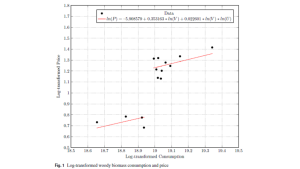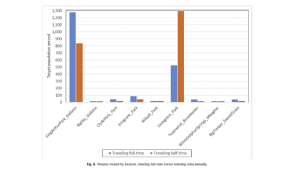Applied operations research uses mathematical optimization approaches in order to support decision making to improve a wide range of application areas: public policy, sustainability, energy, etc. See below for research our faculty are currently conducting.
Projects
Identifying Optimal Multi-state collaborations for reducing CO2 emissions by co-firing biomass in coal-burning power plants
 Abstract
Abstract
Woody biomass provides an opportunity to reduce carbon emissions from existing power plants via co-firing with coal. However, increased demand for woody biomass in electricity generation could potentially increase the price for biomass procurement. This paper presents an econometric demand response model for biomass procurement prices, which is then integrated into a robust mixed-integer nonlinear programming (MINLP) model. We utilize a two-stage approach to efficiently solve this MINLP. The model is then applied to demonstrate the demand-price relationship and to identify efficient frontiers for optimal state partnerships that achieve aggregated CO2 emission rate targets at minimum aggregate cost, subject to a constraint on the probability of satisfying the desired emission targets.
Efficient frontiers in a frontier state: Viability of mobile dentistry services in a rural state
 Abstract
Abstract
This study investigates the implications of adding mobile dentistry services to a community health center (CHC) in a rural area. CHCs are not-for-profit healthcare organizations which provide comprehensive primary care services to patients in the US, primarily for underserved and uninsured populations. We estimate the demand for the service in a five-county region in southwestern Montana, USA and work with stakeholders to determine a set of potential service locations. A mixed-integer optimization model is formulated to determine the frequency of stops in each location over a finite (six month) planning horizon with the goal of improving accessibility and availability of dental services while maintaining financial sustainability of the CHC. The financial considerations and social impact of offering a mobile dentistry service in southwestern Montana are assessed. Computational results based on a case study demonstrate the challenges facing mobile dentistry operations to increase access to under-served populations in a financially viable manner. Hybrid solutions, in which care is offered at a mix of fixed locations and mobile locations, appear to best balance the objectives of financial sustainability and expanded access to care.
Optimal production planning utilizing leftovers for an all-you-care-to-eat food service operation
 Abstract
Abstract
Food service operations in an all-you-care-to-eat environment need to consider two conflicting objectives: a desire to reduce overproduction food waste (and its corresponding environmental impacts), and an aversion to shortfalls (in which some customer demands go unsatisfied). A particular challenge in such buffet-style operations is the absence of any lost marginal revenue associated with lost sales that can be used to measure the shortfall cost, complicating any attempt to determine a minimum-cost solution. This research presents a multi-criteria optimization approach to identify the efficient frontier of points lying between the minimum-waste and minimum-shortfall solutions. In particular, we identify optimal production adjustments relative to demand forecasts, demand thresholds for utilization of leftovers, and percentages of demand to be satisfied by leftovers, considering two alternative metrics for overproduction waste: mass; and greenhouse gas emissions (to account for the embodied chemical usage during farming, transportation, and landfill decomposing of overproduced food waste). A statistical analysis of the changes in decision variable values across each of the efficient frontiers can then be performed to identify the key variables that could be modified to reduce the amount of wasted food at minimal increase in shortfalls (or, alternatively, to reduce the amount of shortfalls at minimal increase in waste). We illustrate our approach with an application to empirical data from Campus Dining Services operations at the University of Missouri. Our analysis suggests that targeted production level modifications, rather than blanket increases or decreases, can allow food service providers to reduce overproduction food waste without significant increases in demand shortfalls.
Improving Road Striping Operations through System Optimization for MoDOT
 Outcomes
Outcomes
Despite the fact that some factors remain unrepresented in the model (e.g., highway ramps requiring striping), the current results of our model can be used to help MoDOT more quickly calculate a striping schedule and dynamically respond to unexpected conditions such as schedule disruptions that occur due to weather or construction delays like chip seal operations not completed on the scheduled date. While MoDOT does not have records from which a comparison between the current and proposed system can be evaluated, the advantage of the genetic algorithm is apparent in the alleviation in time and effort dedicated to manually developing a striping schedule. Assuming MoDOT is able to manually calculate an optimal striping schedule to minimize the total distance traveled, the task still represents an exceedingly lengthy and laborious one. As such, this model provides an ability to significantly reduce the effort necessary to produce said striping schedule as well as test what-if scenarios examining the impact of changing resource levels, policies, etc.